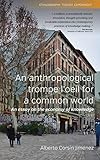An Anthropological Trompe L'Oeil for a Common World : An Essay on the Economy of Knowledge / Alberto Corsín Jiménez.
Material type: TextSeries: Ethnography, Theory, Experiment ; 1Publisher: New York ; Oxford : Berghahn Books, [2013]Copyright date: ©2013Description: 1 online resource (192 p.)Content type:
TextSeries: Ethnography, Theory, Experiment ; 1Publisher: New York ; Oxford : Berghahn Books, [2013]Copyright date: ©2013Description: 1 online resource (192 p.)Content type: - 9780857459114
- 9780857459121
- 301.01 23
- GN33
- online - DeGruyter
| Item type | Current library | Call number | URL | Status | Notes | Barcode | |
|---|---|---|---|---|---|---|---|
 eBook
eBook
|
Biblioteca "Angelicum" Pont. Univ. S.Tommaso d'Aquino Nuvola online | online - DeGruyter (Browse shelf(Opens below)) | Online access | Not for loan (Accesso limitato) | Accesso per gli utenti autorizzati / Access for authorized users | (dgr)9780857459121 |
Frontmatter -- CONTENTS -- List of Illustrations -- Preface -- Zoom In -- Introduction -- Part I. Trompe l’Oeil -- Chapter 1. Surviving Comparison -- Chapter 2. The Strabismic Eye -- Chapter 3. Reversibility/Proportionality -- Zoom Out -- Part II. Common World -- Chapter 4. The Political/Phantasmagoria -- Chapter 5. Predation/Production -- Chapter 6. Exteriority/Interiority -- Conclusion: At Perpendicular Angles -- References
restricted access online access with authorization star
http://purl.org/coar/access_right/c_16ec
Our political age is characterized by forms of description as ‘big’ as the world itself: talk of ‘public knowledge’ and ‘public goods,’ ‘the commons’ or ‘global justice’ create an exigency for modes of governance that leave little room for smallness itself. Rather than question the politics of adjudication between the big and the small, this book inquires instead into the cultural epistemology fueling the aggrandizement and miniaturization of description itself. Incorporating analytical frameworks from science studies, ethnography, and political and economic theory, this book charts an itinerary for an internal anthropology of theorizing. It suggests that many of the effects that social theory uses today to produce insights are the legacy of baroque epistemological tricks. In particular, the book undertakes its own trompe l’oeil as it places description at perpendicular angles to emerging forms of global public knowledge. The aesthetic ‘trap’ of the trompe l’oeil aims to capture knowledge, for only when knowledge is captured can it be properly released.
Mode of access: Internet via World Wide Web.
In English.
Description based on online resource; title from PDF title page (publisher's Web site, viewed 25. Jun 2024)


